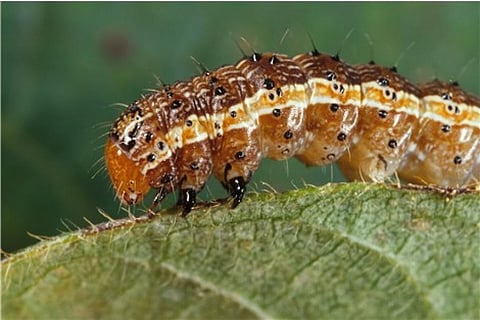

A research paper, prepared by a group of scientists from non-profit The Centre for Agriculture and Bioscience International (CABI) and the University of Exeter, UK has warned that the invasion by Fall Armyworms (Spodoptera frugiperda) could become global.
Titled “Forecasting the global extent of invasion of the cereal pest Spodoptera frugiperda, the Fall Armyworm”, the paper has been written by Regan Early of University of Exeter and Pablo Gonzalez-Moreno, Sean T Murphy and Roger Day from CABI.
The study says there is a possibility of the Fall Armyworm migrating to Europe. Annually, Fall Armyworms migrate 1,700 km. The recent invasion of Fall Armyworms in India’s southern states like Karnataka, Tamil Nadu and Andhra Pradesh has brought revealed this fact.
The study also enumerates climate change as well as rising trade and transportation between infected and non-infected regions as the reasons behind the invasion of Fall Armyworms, which potentially puts the world’s food security at risk.
The study clearly indicates that hot and humid temperatures (between 20 and 32 Degrees Celsius) and long dry spells are favourable factors for Fall Armyworm production.
Mapping the potential spread
The study has mapped the potential spread of the Fall Armyworm. In India, the area adjoining Karnataka, Andhra Pradesh, Telangana and Tamil Nadu are pointed as high risk zones. Globally, Sub-Saharan Africa, South America, Central America and Southeast Asian countries are at risk.
(Source: CABI and University of Exeter, UK: The greener parts are suitable region for its habitat. The lower value indicates lesser infestations. As the index number value increase the region is more prone to Fall Armyworm infestations)
The study indicates that the migration route to India is also possible through the Southwest monsoon that blows from Africa to India every year through June to September. Trade is another route of spreading it to different countries.
In Africa, the region extending from the Sahel to South Africa are the most prone to the Fall Armyworm as the climate is highly suited for it to survive throughout the year. North Africa is less suited for the worm’s year-round existence.
But even in Sub-Saharan Africa, the study points out that there are some nations like Congo (Brazzaville), DRC, Gabon and Cameroon, that have low suitability for the worm because of high density of forest cover.
The study says that the factors that could most deter the worm’s spread are low temperature, high density of forest cover and good spell of rains (3 months) during the rainy season.
Trade routes
South Asia, Southeast Asia and Australia are also highly suitable for the Fall Armyworm to grow year-round.
The pest was first observed in Spain in 2006. It most-likely originated in Chile. It colonised the Middle East and Northeast Africa around 2012 and parts of Sub-Saharan Africa from about 2014. It was introduced to Africa by passengers travelling by air.
It was recorded for the first time in India in 2014. It seems to have entered the country most likely with air passengers or freight.
According to the study, if the trade volume between the source country and vulnerable destination is more than $500 million, there is a greater possibility of the vulnerable place importing the worm. Also, if more than 10,000 passengers travel from a source country to vulnerable areas, the chances of importing the Armyworm increase considerably.
Europe under shadow
Although the Fall Armyworm does not usually inhabit North Africa, there are some areas like
Morocco, the Nile Valley of Egypt and Sudan, where it can proliferate during the wet parts of the year.
According to the study, there is a possibility that the worm could spread from these areas to neighbouring countries in Southern Europe like Italy and Greece.
The paper suggests that managing the Fall Armyworm at a single location cannot serve the purpose of destroying it. What is needed is coordination across region and country boundaries.
| What is Fall Armyworm?
It is a polyphagous (feeding on many foods) pest. It can attack cereals and forage grasses. It is recorded as eating 186 plant species from 42 families. It generally feeds on leaves as well as fruit (in the case of flowering corn). It attacks male flowering parts called ‘tassel’ and female flowering part called ‘ear’ at an early stage before tidbits grow on them. The larvae can cause damage to maize plants at nearly all stages of their development. There are two genetically identified Fall Armyworms which have different characteristics. One is referred to commonly as the rice-strain (R) and other is the maize-strain (M). The R-strain attacks rice, pasture, turf grass, Bermuda grass, millet and alfalfa, whereas the M-strain attacks maize, sorghum and cotton. According to the paper, these two strains also have different timing for mating activities. For the M-strain, mating occurs early at night while for the R-strain, it occurs during the last half of the night. The Fall Armyworm has the ability to travel 1,700 km during its annual migration in North America. |